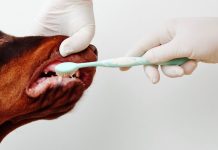If you adore your cats – and who doesn’t? – you will want to keep them happy and healthy. One of the problems, however, that many don’t address, is the health of her teeth.
Cats suffer from dental disease just like humans do but, unlike dogs, brushing a cat’s teeth can be difficult if not started in kittenhood.
Gum disease in cats typically begins as they age and is a build up of plaque on her teeth from bacteria formed after she has eaten. Periodontal disease affects the bone structure of her teeth as well as her gums. Here’s some information about cat dental disease in felines that will help you keep your cat healthy.
In the Beginning
The culprit in feline dental disease is something called plaque. It starts off as a thin film over your cat’s teeth but builds up over time into tartar which is a thick, hard surface. This is the same substance that your dental hygienist removes from your teeth twice a year.
Tartar, unlike plaque, is visible and tends to be either brown or yellow. As a result of this, your vet may need to clean your cat’s teeth under general anesthesia.
Where Diet Comes Into Play
Your cat’s diet may have a lot to do with whether she develops periodontal disease. If you tend to feed her wet or soft food only, she may develop gum disease a lot faster than a cat who eats a mixture of wet and dry or only dry.
What’s the Difference?
That difference is in the abrasiveness of the food. Dry kibble tends to act as an abrasive on a cat’s teeth and take the plaque off. You can also buy specially formulated kibble that helps reduce plaque and tartar on your cat’s teeth.
Diagnosis
Diagnosis of periodontal disease in your cat comes from x-rays that will help show your vet the percentage of bone loss found in your cat’s mouth. The more advanced the disease, the more loss of bone support for your cat’s teeth.
Management
Depending on the severity of the disease, your vet may ask you to bring your cat in for regular checkups in order to determine how fast the disease is growing and also to help prevent it from advancing further.
Talk to your vet about brushing your cat’s teeth regularly and how to do it safely. Prevention of gum disease starts with regular maintenance and good treatment of any issues that come up.
Image Credit: istockphoto.com
Have you dealt with a cat dental disease? For other great tips on feline health, click the links below!
Your Cat Is Pregnant: Now What?
What To Do If Your Cat Eats A Poisonous Plant?











